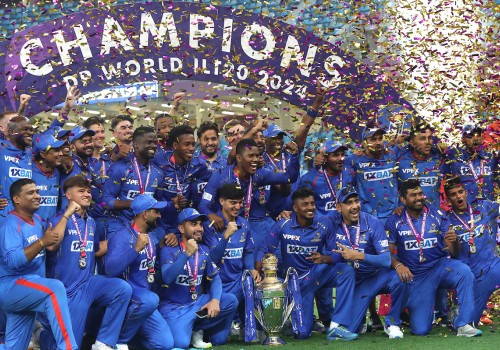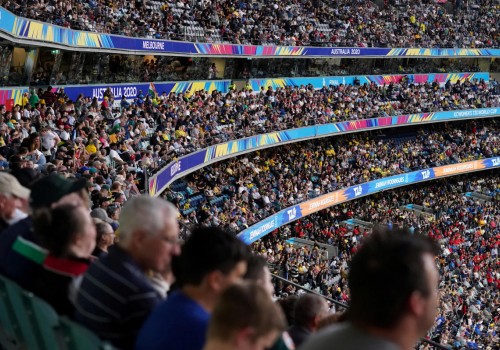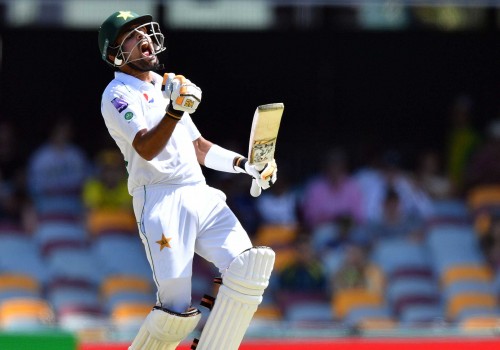Pakistan ICC Cricket World Cup 2019 profile
As part of our lead up to the ICC World Cup 2019 hosted by England and Wales, Expat Sport will bring you in depth profiles of all ten qualifying teams set to put bat to ball when cricket’s premier competition begins next May. We look at the players, coaches, the highs and lows of form and make a nod to those we believe will make a success of their bid to be crowned champions of the World.
Pakistan – How high will the Falcons fly
Cricket in Pakistan is steeped in history; it even pre-dates the country’s creation in 1947. The first international match took place in Karachi in 1935 between the Sindh and Australian teams in front of 5,000 spectators.
Five years later, Pakistan was awarded Test match status at a meeting of the Imperial Cricket conference at Lord’s Cricket Ground in England on 28th July 1952 following a recommendation by India.
The Pakistan national cricket team popularly referred to as the Shaheens in Urdu (Falcons in English), as well as the Green Shirts and Men in Green, is administered by the Pakistan Cricket Board (PCB). It is a full member of the International Cricket Council (ICC), and therefore an official participant in all Test, ODI and Twenty20 International cricket series and competitions.
Fears of ongoing terrorist attacks in 2009, following a major incident involving the Sri Lankan cricket team, meant that Pakistan have had to play most of their home games outside the country in the United Arab Emirates for a number of years. However, since 2015 several teams, including Sri Lanka, Zimbabwe and West Indies, have toured Pakistan without mishap and the security situation appears to have consistently improved.
At the time of writing, the Pakistani teams have played 899 ODIs, winning 476, losing 397 and tying 8 games with 18 matches ending in no-result. The side ended 1992 as World Cup champions, and were worthy runners-up in the 1999 tournament. Pakistan, in conjunction with other countries in South Asia, hosted the 1987 and 1996 World Cups, the 1996 final being played at Gaddafi Stadium in Lahore. In 2017 the team also won the ICC Champions Trophy for the first time, defeating India. Pakistan currently hold 5th place in the ICC ODI rankings, marginally above Australia.
A winning 2017
Last year was a good one for Pakistani limited-overs cricket, a tour of the West Indies ended in 2-1 ODI and 3-1 T20I series victories for the visitors. Most would consider that a near perfect build up to the lCC Champions Trophy 2017 campaign later that year. Yet, Pakistan made a poor start to the tournament, going down to arch rivals India by 124 runs. Still the Pakistan bowling attack picked up steam as they moved through the group stages, beating South Africa by 19 runs and took a crucial game against Sri Lanka by 3 wickets. Then it was the underdogs against England in the semi-final, and the odds were fairly well stacked against Pakistan, with England both hosts and favourites. Enter Hasan Ali, who proceeded to bowl out of his skin, grabbing the three pivotal wickets of Jonny Bairstow, Eoin Morgan and Ben Stokes, taking his team into their first ICC Champions Trophy Final, a high pressure rematch with India.
It was a packed house at The Oval, the ground where five games of the ICC Cricket World Cup 2019 will be played. India won the toss and chose to bowl. However, India would come to regret that decision on a docile pitch, as opening bat Fakhar Zaman hit a sizzling maiden ODI century of 114 off 106 deliveries to set the platform, assisted by barnstorming innings from Azhar Ali 59 and Mohammad Hafeez 57 not out, bringing the Pakistan total up to 338. At the crease, India’s top order fell cheaply, with Mohammad Amir taking the key wickets of Rohit Sharma, Shikhar Dhawan and Virat Kohli for 26. Hardik Pandya steadied the ship with a crisp 76, but that man Hasan returned to take 3 for 19 leaving India 180 runs short of the chase, and Pakistan to win their first Champions Trophy. The margin of victory broke the record for an ICC tournament final.
Roll forward to 2018
Earlier this year, Pakistan played a mini-Test series against Ireland, beating them 1-0 by 5 wickets and England, with whom they drew 1 – 1 winning the first match by 9 wickets but losing the second by an innings and 55 runs. All of the games took place in May. The team then embarked on an ODI tour of Zimbabwe in the July, but were rarely tested and ended up winning all 5 games comfortably.
The Asia Cup 2018 played in the United Arab Emirates was Pakistan’s next engagement. Certainly a home ground location that suited them but against a level of competition, which provided the best indication yet as to where their ODI squad cricket stands in terms of the ICC Cricket World Cup 2019.
Pakistan came second in Group A losing to India but beating the third team Hong Kong, Afghanistan topped Group B followed by Bangladesh, with Sri Lanka out
Therefore Pakistan made the Super Fours stage but failed to shine. They beat Afghanistan by 3 wickets, but lost to by 37 runs to Bangladesh and were then subjected to a 9 wicket drubbing by India, who went on to beat Bangladesh in the final on 28th of September.
Frankly speaking, an exceptionally young Pakistan team, appears to have been undone by a lack of quality cricket game-time. The team has come under huge criticism for a poor performance in all departments; bowling, fielding and batting. Former captain, and much admired all-rounder Shahid Afridi, tweeted:
“Congratulations Bangladesh, disappointed by Pakistani team’s overall performance. [It] Lacked attacking play of cricket in all fields.”
He went on to highlight the team’s lack of match practice, saying:
“It’s a young side who performed well in the last tournaments & set our expectations high. More focus and practice is needed for a stronger comeback.”
The next stage of development
Looking forward to autumn and winter, Pakistan are set for a plethora of intense game time against stiff opposition in their adopted home in the United Arab Emirates (UAE). This is exposure is undoubtedly needed, if the team is to put up any kind of fighting performance in next year’s World Cup.
They play two home Tests and a 3-match T20I series in the UAE in October against Australia. Closely followed by a 3-game T20I, 3-game ODI and three Test series against New Zealand, also to be played in the UAE spanning November and December.
The Shaheen will then continue the high work rate, moving on to pitches new to play another full-blooded three Test, 5-game ODI and three-game T20I series starting at the end of December 2018 extending into February 2019 on a tour of South Africa.
Given this programme, we must assume that Pakistan’s ODI squad will be in much better condition than it was going into the recent Asia Cup. However, there are a number of structural problems going forward that need resolving if the team is to regain some real winning momentum.
Pakistan ODI squad review following the Asia Cup
The top batting order failed once again, finding reliable consistent openers has been a longstanding problem for the Pakistani team since the days of Amir Sohail and Saeed Anwer. There have been various experiments and just when it looked like a pairing of Fakhar Zaman and Imamul Haq had proved relatively successful in recent tours they crashed during the Asia Cup. Fakhar Zaman, demonstrating considerable fallibility against spin.
There appears to be an over dependence on youngsters. The selection committee dropped senior players Muhammad Hafeez and Azhar Ali, despite their solid performances in One Day Internationals, particularly in the ICC Champions Trophy, where a good opening pair including Azhar gave Pakistan strong starts throughout the tournament. Hafeez was also another surprise exclusion from the middle order, as team management chose youth over international form and experience except for Shoaib Malik. Malik delivered absolute evidence as to the value of senior players in the team, as the only man holding the middle order together, navigating Pakistan to their win over Afghanistan in the Asia Cup virtually single handed.
Following the ICC Champions Trophy, Pakistan received a flurry of compliments for the team’s fielding prowess, which had never been the green shirts’ forte. An improvement credited to head coach Mickey Arthur, and Pakistani fans lived in hope that the previous era of sloppy dropped-catch fielding had been consigned to the history books. However, it appears that old habits die hard and the side are up to their old tricks again. Before their last match in the Asia Cup, Pakistan’s fielders had dropped six catches and held five.
Even Pakistan’s captain Sarfraz Ahmed’s was in poor nick. His last good performance being against Sri Lanka in the ICC Champions Trophy, a match in which he lead from the front and won for the team. Unfortunately since that triumph, Ahmed’s batting average has slumped. The only decent knock coming, as a result of having pushed himself up the order in an Asia Cup game, to score 44 from 66 balls, but then only managing 10 against Bangladesh in the last match. Pundits cited the captain’s decline in form as one of the major reasons behind the ODI side’s uninspired showing in the tournament.
Finally Pakistan were accused by former players and fans alike of taking a defensive approach after the defeat handed out by India, in the first match of the Asia Cup. The observation was that for some reason the team slid into defence mode, which gave the opposition an immediate psychological advantage. Noticeably, Sarfraz actually withdrew the first slip during the opening 15 overs, a tactic which he had never adopted prior to the tournament. This overly defensive policy most certainly proved of benefit to competing teams as they were able to accumulate easy runs in their middle orders. In the final Asia Cup game, Pakistan had Bangladesh on 13 for 3 at one point, but their defensive tactics allowed Mushfiqur Rahman and Mohammad Mithun to settle, and simply take the game away from them.
All of which points to the fact that Pakistan players and coaching staff have an awful lot of hard work to do to get in any kind of shape for the ICC Cricket World Cup 2019. An autumn/winter season of cricket against Australia, New Zealand and then South Africa will no doubt help resolve the best squad line up, but it will also be a make or break period against top class opposition. A defensive approach cannot be an option as the team has to learn to win again. Any kind of ‘whitewash’ however, needs to be avoided, so a fine line. Nevertheless, it can be done given the lengthy period of quality game time ahead, but there are a number of Pakistani cricketing elder statesmen who might urge the return of some senior players to help get the balance right.
Expat Sport’s Mac McTiernan, takes a view of the current state of play in Pakistani ODI cricket following the recent Asia Cup and looks at what the future holds for the national squad in their build up to the ICC Cricket World Cup next year in England and Wales.




